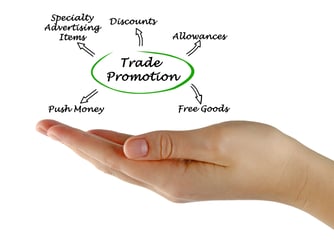If you manage a CPG business, you probably recognize how much more efficient and profitable you’d be if you improved your trade spend practices. But how do you that? To optimize your trade spend, you need to understand how effective your trade spend decisions are, track each promotion’s ROI, compare promotions, and quickly respond to competitors’ trade spend maneuvers.
How critical is trade promotion management (TPM)? According to Accenture, trade promotion spend has doubled since 2000 and is now widely accepted to represent 20% of revenue, on average, for CPG companies.
What’s the Problem with Current TPM Practices?
 Gartner summarized the state of TPM in their 2017 report, Market Guide for Trade Promotion Management and Optimization for the Consumer Goods Industry: “Consumer goods manufacturers continue to spend a significant portion of their budgets managing promotions and price reductions as a part of collaborative efforts with retail partners.” But if trade promotions have such a major effect on the revenue and cost sides of a business, why do the majority of CPG companies continue to rely on Excel spreadsheets to manage their trade promotions?
Gartner summarized the state of TPM in their 2017 report, Market Guide for Trade Promotion Management and Optimization for the Consumer Goods Industry: “Consumer goods manufacturers continue to spend a significant portion of their budgets managing promotions and price reductions as a part of collaborative efforts with retail partners.” But if trade promotions have such a major effect on the revenue and cost sides of a business, why do the majority of CPG companies continue to rely on Excel spreadsheets to manage their trade promotions?
Excel wasn’t designed to manage the processes and complexities of TPM, and that disconnect is leading to major profitability problems for CPG companies.
A proper TPM solution needs to align information and processes between sales, marketing, and manufacturing to ensure effective and efficient trade promotions. Then, to continuously improve, you need to measure all aspects of your TPM, which is why AMR Research stated, “Promotion effectiveness is the measurement of the results of a promotional activity based on uplift, cost, margin, profit, revenue, and account management considerations.”
How Modern ERP Optimizes TPM
Based on TPM’s requirement to connect information and processes between numerous functional areas, it makes sense that your company leverages an enterprise-wide information system to do so. The TPM capabilities within modern ERP systems like SAP Business One (SAP B1) are helping food and beverage distributors move beyond Excel and other home-grown tools to perform robust TPM.
To start, SAP B1’s campaign management tools keep customers and partners updated regarding current and planned promotional events. Then, the system provides full promotion planning and execution with web-based CRM functionality, enabling planning and real-time measurement and offering the ability to break down promotions by brand, product line, individual product, etc. Then, during promotions, you can monitor their success on their own and relative to other promotions.
As different trade promotions happen, the real-time sales data and existing forecasting data within SAP B1 make your production planning more accurate. Planners gain short-term and long-term production plans based on better data, ensuring they account for additional volumes generated by each promotion.
SAP B1 also enables forecasting product and inputs necessary for future promotions. You can view volume and spending forecasts based on promotional and non-promotional timeframes, helping your supply chain planners anticipate ordering needs the next time there’s a promotion for a specific product. The more historical data SAP B1 captures, the more accurate your planning grows. That’s because a multitude of business conditions can be aggregated and analyzed in SAP B1 with scale and accuracy unmatchable by manual or Excel-based TPM.
The Benefits of Switching to Modern ERP for TPM
By leveraging the unified information and processes within SAP Business One, you’ll gain real-time visibility into promotion effectiveness and efficiency. You’ll increasingly attract more refined segments of customers with perfectly-timed promotions that draw their attention, helping you build brand awareness, improve customer loyalty, and grow customer lifetime value. At the same time, you’ll eliminate the back-end risks associated with promotions, including purchasing too much stock, experiencing stock-outs, and losing profits.
To find out more about making robust TPM part of your CPG business, contact us today.






Leave a comment